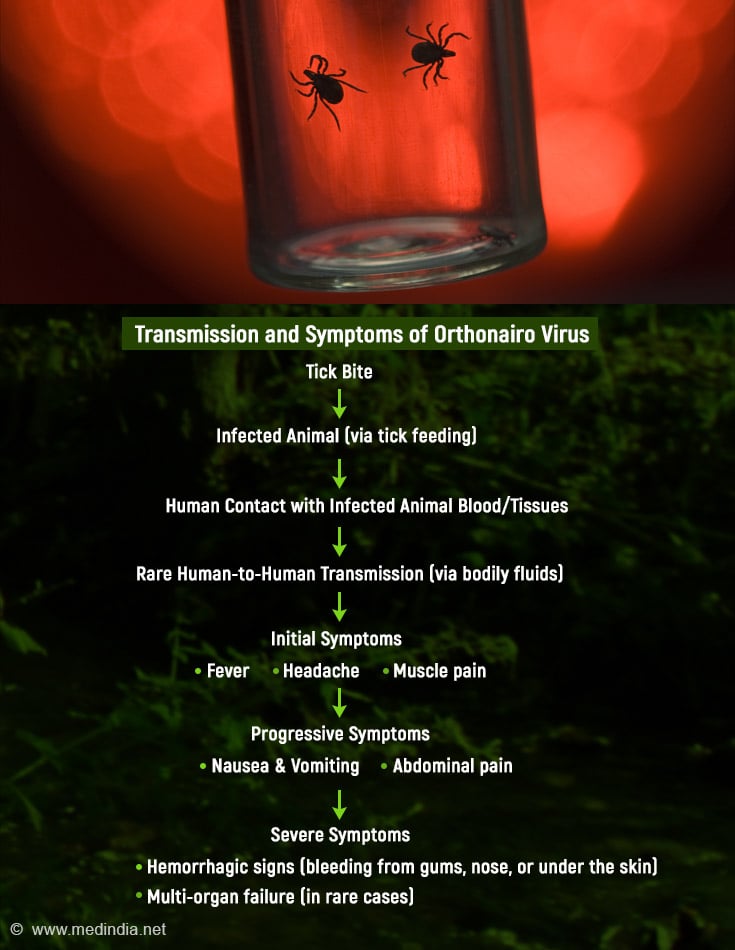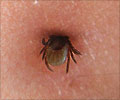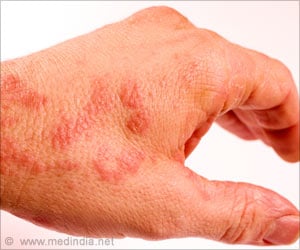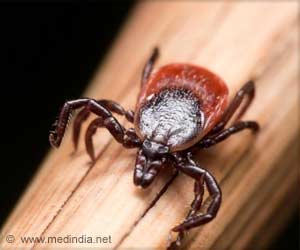- A New Orthonairovirus Associated with Human Febrile Illness - (https://pubmed.ncbi.nlm.nih.gov/39231344/)
About
Orthonairovirus is a tick-borne virus responsible for a variety of diseases, especially hemorrhagic fevers. These viruses are named after the region where they were first discovered, Nairobi (hence Nairovirus). Some well-known viruses under this genus include the Crimean-Congo hemorrhagic fever virus (CCHFV), Dugbe virus, and Nairobi sheep disease virus.
Did You Know?
Certain Orthonairovirus species, like Crimean-Congo hemorrhagic fever virus (CCHF), have a fatality rate of up to 40% in severe cases. #orthonairovirus #tickborne #medindia
The Orthonairovirus has a single-stranded, negative-sense RNA genome that is segmented into three parts:
- Large (L) segment: Encodes the RNA polymerase.
- Medium (M) segment: Encodes the glycoproteins that allow the virus to bind to host cells.
- Small (S) segment: Encodes the nucleocapsid protein that helps protect the viral RNA.
The virus is enveloped, which makes it more sensitive to environmental factors like heat and detergents, but still resistant enough to persist in certain conditions like within tick populations(1✔ ✔Trusted Source
A New Orthonairovirus Associated with Human Febrile Illness
Go to source).
Transmission of Orthonairovirus
Tick-Borne Transmission
Ticks, specifically those in the Ixodidae family (hard ticks), are the primary vectors for Orthonairovirus. The virus is maintained in a tick-animal-tick cycle. Humans generally become infected through tick bites or contact with the blood or tissues of infected animals. Certain species, like livestock, are common hosts for the virus, and the ticks feeding on these animals help sustain the virus’s lifecycle.
Human-to-Human Transmission
While Orthonairovirus infections are primarily tick-borne, there are rare cases of human-to-human transmission, especially in healthcare settings. This can occur through contact with the blood or bodily fluids of an infected individual. In particular, the Wetland virus can pose a risk for those working in environments like wetlands or in close contact with wildlife and livestock.
The Wetland Virus: A Member of the Orthonairovirus Genus
The Wetland virus is a lesser-known member of the Orthonairovirus genus. It primarily affects animals living in or around wetlands, such as waterfowl, and can occasionally infect humans. Like other Orthonairoviruses, it is transmitted via ticks, and the ecological nature of wetlands makes it a unique environment for the virus’s transmission.
The Wetland virus was discovered in regions where wetlands are abundant, including parts of Europe and Africa. Though relatively rare, sporadic cases have been reported where humans contracted the virus after being bitten by infected ticks while visiting wetland areas. The exact epidemiology is still being studied, and it’s not fully clear how widespread the virus is across wetland habitats.
Symptoms and Effects of Orthonairovirus Infections
In Animals
Many Orthonairoviruses, including the Wetland virus, are capable of infecting domestic and wild animals. Infected animals often show mild or no symptoms, though some may develop fever, lethargy, or hemorrhagic signs depending on the virus strain. In rare cases, animals may die, particularly if they have other underlying health issues.
In Humans
In humans, Orthonairovirus infections, including those caused by the Wetland virus, can present a range of symptoms. Some individuals may remain asymptomatic, while others may experience severe symptoms such as:
- Fever
- Headache
- Muscle pain
- Vomiting and nausea
- Abdominal pain
- Hemorrhagic symptoms (bleeding from gums, nose, or under the skin)
Severe cases can lead to multi-organ failure and death, particularly when untreated. The symptoms typically develop within a few days to two weeks after exposure to the virus through a tick bite or contact with infected animals.

Diagnosis of Orthonairovirus Infections
Laboratory Tests
Diagnosis is typically made through laboratory tests that detect the presence of the virus in blood or tissue samples. Some of the common diagnostic techniques include:
- PCR (Polymerase Chain Reaction): This test detects viral RNA in a patient’s blood.
- Serology: This involves detecting antibodies in the patient’s blood that are specific to the virus.
- Virus isolation: In specialized laboratories, the virus can be cultured from a sample.
Early diagnosis is crucial for managing the symptoms effectively and preventing further spread, especially in healthcare settings where human-to-human transmission may occur.
Treatment of Orthonairo Virus
There is no specific antiviral treatment for Orthonairovirus infections, including those caused by the Wetland virus. Treatment primarily focuses on supportive care, such as:
- Rehydration therapy: To manage dehydration caused by vomiting and diarrhea.
- Pain management: For headaches, muscle pain, and other symptoms.
- Management of hemorrhagic symptoms: This may include blood transfusions in severe cases.
Some research suggests that the antiviral drug ribavirin may have some effectiveness in treating certain Orthonairovirus infections like CCHF, but its efficacy against the Wetland virus is not yet confirmed.
Preventative Measures
Tick Control
Because ticks are the primary vectors, controlling tick populations is crucial to preventing Orthonairovirus infections. This can be achieved through:
- Use of tick repellents: Especially when in wetland or forested areas.
- Wearing protective clothing: Long sleeves and pants to minimize skin exposure.
- Regular tick checks: After spending time outdoors in areas where ticks are common.
Environmental Control
Managing tick populations in wetland areas can help reduce the spread of the Wetland virus. This might include controlled burning, the use of acaricides (pesticides that kill ticks), and habitat management that reduces tick-friendly environments.
Public Awareness and Education
People working in wetlands or with wildlife should be educated on the risks of tick-borne viruses and the importance of preventative measures. Public health campaigns can also help raise awareness about the symptoms of Orthonairovirus infections and encourage prompt medical attention if symptoms appear after a tick bite.
Summary
The Orthonairovirus genus, including the Wetland virus, is a group of tick-borne viruses capable of causing severe diseases in both humans and animals. While much is known about more prominent members of this genus, such as Crimean-Congo hemorrhagic fever, lesser-known viruses like the Wetland virus are still being studied for their potential impact on public health.
Preventative measures focused on tick control, public education, and early detection are crucial in minimizing the spread and impact of these viruses. Ongoing research will continue to shed light on the ecology, transmission, and treatment of Wetland virus infections, as well as other members of the Orthonairovirus genus.









